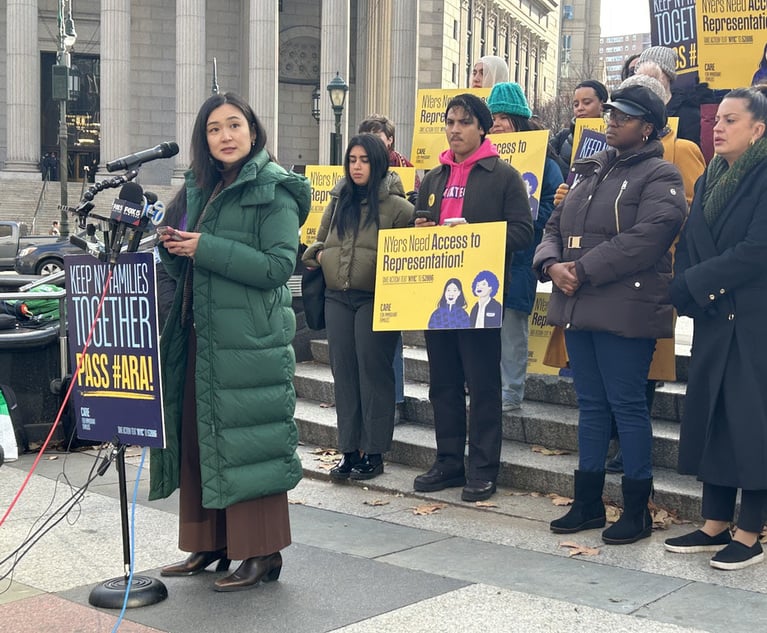With Criminal Justice Reforms Coming, Albany DA Repurposes Old Tool With New Ideas
"We're dead in the water without it," Soares said of the fiber optic network that streamlines communication among county agencies.
December 19, 2019 at 04:30 PM
7 minute read
 Albany District Attorney David Soares.
Albany District Attorney David Soares.
As prosecutors in New York continue to scramble for ways to comply with the state's sweeping new set of criminal justice laws, namely a tighter deadline on disclosing evidence to defense attorneys, Albany County District Attorney David Soares stumbled upon a reprieve.
It was already in place, stretching from the county building of Albany to the various municipalities within its jurisdiction, and it's expected to save a lot of time.
"We're dead in the water without it," Soares said of the fiber optic network that streamlines communication among county agencies.
That's not an exaggeration—the tool that Soares decided to repurpose to comply with the new criminal justice laws will enable his office to receive information in just minutes from members of local law enforcement, who would otherwise take hours to do the same thing.
It's the county's fiber optic network—a direct connection between the county and the various law enforcement agencies within its borders.
It wasn't installed for how Soares intends to use it when the state's new laws take effect Jan. 1. Its original purpose was related to 911 calls in Albany County, but the infrastructure established by the network was exactly what they needed, Soares said.
The network has been in place for awhile, said Heather Orth, chief of staff for the Albany County District Attorney's Office. It's rarely used as it is, she said, but the state's impending criminal justice laws will give it a new purpose at the start of next year.
"We started analyzing our own workflow and talking to police departments," Orth said. "In doing so, we realized we had a gem in Albany County."
The state's new law will require prosecutors to disclose criminal discovery to defense attorneys within 15 days of their client's arraignment. Discovery can be anything from an initial arrest report to video footage from an officer's body camera, which can sometimes be a large file.
There are safety net provisions in the law that would allow prosecutors to delay the 15-day deadline by another month if the amount of discovery they're compiling for the defense is considered "voluminous," but that's up to the judge hearing the case.
But the 15-day deadline is for prosecutors, not members of law enforcement. That makes compiling discovery for the defense complicated.
Local law enforcement agencies, under the law, will have to send all information related to a case to their local district attorney, who will prosecute the case. Those prosecutors then have to go through that information and prepare it for discovery.
The 15-day deadline for prosecutors will depend on when they get the relevant information from members of law enforcement. If that takes seven days, for example, prosecutors only have eight days to compile the information for defense attorneys.
That's not as simple as it sounds. Prosecutors have to go through each piece of evidence, individually, and take out any information or images that aren't relevant to the case. They may have to blur out faces in a video or redact names on documents, for example.
But before any of that happens, members of law enforcement have to get the files to prosecutors. For large files, that can present a challenge. Burning those files onto discs, or uploading them to a secure space, can take awhile.
That's where the fiber optic network in Albany County comes in. Rather than spending hours uploading those files, or having them physically sent to prosecutors, members of law enforcement can use the network to transmit that information in minutes.
"It's going to be something that's going to be so fantastically helpful to us, because it's the mechanism with which we're going to be able to get all the materials from police departments," Orth said.
Think of it as a direct connection between the Albany County District Attorney's Office and the various law enforcement agencies with which it works.
While the network is expected to speed things up, the Albany County District Attorney's Office still expects there to be challenges when the laws are set to take effect in about two weeks. It's easy to think of fulfilling one case, Orth said, but they handle about 10,000 each year.
"It sounds easy—we can just transfer data digitally. But the reality is that we need people to make the technology work," Orth said. "The volume just becomes so immense."
While Albany County was fortunate to discover it had an already-existing network that could be used to easily transfer large files, other counties aren't as lucky. Soares, a past president of the District Attorneys Association of the State of New York, said that benefit isn't likely to be shared universally.
"There are going to be some communities that don't have that luxury," Soares said.
That means those communities will have to ask for funding, either from their municipalities or the state, to build out a fiber optic network if they want to go that route. Orth said Albany County spent $290,000 just to upgrade their network to its current state in recent months.
That's on top of the other financial implications of the state's new laws, particularly when it comes to prosecutors with small offices outside New York City.
Soares said Thursday his office was seeking to add 35 new positions just to comply with the state's new laws on criminal discovery. So far, they've been able to add nine of those positions, but he's planning to ask for more in the future.
On a tour of the Albany County District Attorney's Office on Thursday, staff showed reporters where they've carved out space for the new positions, and the technology that comes with them. Aside from staff, they've purchased several new scanners to digitize files.
As of now, the office has marked off two small rooms to house employees whose sole job is to work on discovery demands. The space was previously used by staff from the Crimes Victims Unit, who have now been relocated.
Soares said he could use more space, but that the money, as of now, wasn't there. He's asked the state to set aside funding in the coming year for prosecutors, like him, who don't want the cost of the new reforms to be borne by local governments.
"We continue to engage our state representatives because we believe they continue to have an obligation here," Soares said.
READ MORE:
No Plans to Delay, Change NY's New Criminal Justice Laws, Senate Leader Says
Assembly Speaker Says There's No Appetite to Delay NY Criminal Justice Laws Amid Cost Concerns
Mayors in NY Join Call for More State Funding to Implement Criminal Justice Reforms
More Funding Needed for Pretrial Services Ahead of NY Bail Reform, Supporters Say
New Funding for Pretrial Services Agencies Left Out of NY Bail Reform Law
This content has been archived. It is available through our partners, LexisNexis® and Bloomberg Law.
To view this content, please continue to their sites.
Not a Lexis Subscriber?
Subscribe Now
Not a Bloomberg Law Subscriber?
Subscribe Now
NOT FOR REPRINT
© 2025 ALM Global, LLC, All Rights Reserved. Request academic re-use from www.copyright.com. All other uses, submit a request to [email protected]. For more information visit Asset & Logo Licensing.
You Might Like
View All
So Who Won? Congestion Pricing Ruling Leaves Both Sides Claiming Victory, Attorneys Seeking Clarification
4 minute read
Hochul Vetoes 'Grieving Families' Bill, Faulting a Lack of Changes to Suit Her Concerns

Court System Names New Administrative Judges for New York City Courts in Leadership Shakeup
3 minute read
Trending Stories
- 1Judge in NYC Mayor's Public Corruption Case Has a Reminder for Advocates
- 2Former US State Dept. Official Joins King & Spalding Investigations Group
- 3Juror No. 3 Challenges Florida Defense Counsel During Closing Argument
- 4Fourth Circuit Seeks More Legal Briefs in Unresolved N.C. Supreme Court Election
- 5iRobot Picks Up Law Firm Partner as New Legal Chief
Who Got The Work
Michael G. Bongiorno, Andrew Scott Dulberg and Elizabeth E. Driscoll from Wilmer Cutler Pickering Hale and Dorr have stepped in to represent Symbotic Inc., an A.I.-enabled technology platform that focuses on increasing supply chain efficiency, and other defendants in a pending shareholder derivative lawsuit. The case, filed Oct. 2 in Massachusetts District Court by the Brown Law Firm on behalf of Stephen Austen, accuses certain officers and directors of misleading investors in regard to Symbotic's potential for margin growth by failing to disclose that the company was not equipped to timely deploy its systems or manage expenses through project delays. The case, assigned to U.S. District Judge Nathaniel M. Gorton, is 1:24-cv-12522, Austen v. Cohen et al.
Who Got The Work
Edmund Polubinski and Marie Killmond of Davis Polk & Wardwell have entered appearances for data platform software development company MongoDB and other defendants in a pending shareholder derivative lawsuit. The action, filed Oct. 7 in New York Southern District Court by the Brown Law Firm, accuses the company's directors and/or officers of falsely expressing confidence in the company’s restructuring of its sales incentive plan and downplaying the severity of decreases in its upfront commitments. The case is 1:24-cv-07594, Roy v. Ittycheria et al.
Who Got The Work
Amy O. Bruchs and Kurt F. Ellison of Michael Best & Friedrich have entered appearances for Epic Systems Corp. in a pending employment discrimination lawsuit. The suit was filed Sept. 7 in Wisconsin Western District Court by Levine Eisberner LLC and Siri & Glimstad on behalf of a project manager who claims that he was wrongfully terminated after applying for a religious exemption to the defendant's COVID-19 vaccine mandate. The case, assigned to U.S. Magistrate Judge Anita Marie Boor, is 3:24-cv-00630, Secker, Nathan v. Epic Systems Corporation.
Who Got The Work
David X. Sullivan, Thomas J. Finn and Gregory A. Hall from McCarter & English have entered appearances for Sunrun Installation Services in a pending civil rights lawsuit. The complaint was filed Sept. 4 in Connecticut District Court by attorney Robert M. Berke on behalf of former employee George Edward Steins, who was arrested and charged with employing an unregistered home improvement salesperson. The complaint alleges that had Sunrun informed the Connecticut Department of Consumer Protection that the plaintiff's employment had ended in 2017 and that he no longer held Sunrun's home improvement contractor license, he would not have been hit with charges, which were dismissed in May 2024. The case, assigned to U.S. District Judge Jeffrey A. Meyer, is 3:24-cv-01423, Steins v. Sunrun, Inc. et al.
Who Got The Work
Greenberg Traurig shareholder Joshua L. Raskin has entered an appearance for boohoo.com UK Ltd. in a pending patent infringement lawsuit. The suit, filed Sept. 3 in Texas Eastern District Court by Rozier Hardt McDonough on behalf of Alto Dynamics, asserts five patents related to an online shopping platform. The case, assigned to U.S. District Judge Rodney Gilstrap, is 2:24-cv-00719, Alto Dynamics, LLC v. boohoo.com UK Limited.
Featured Firms
Law Offices of Gary Martin Hays & Associates, P.C.
(470) 294-1674
Law Offices of Mark E. Salomone
(857) 444-6468
Smith & Hassler
(713) 739-1250






